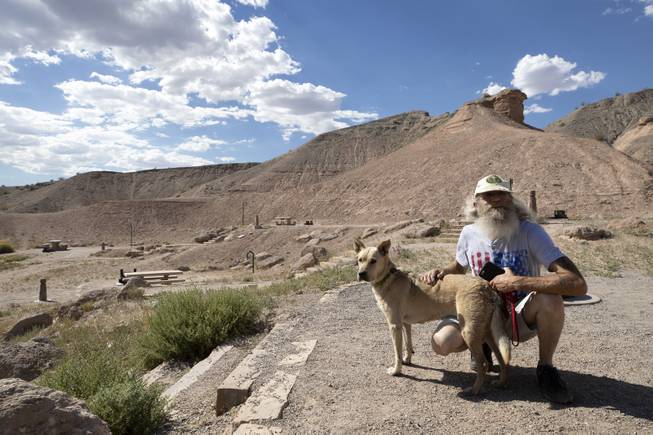
Phillip Robinson of Golden Valley, Ariz. and his dog Rider check out the campground at Willow Beach, Ariz. in the Lake Mead National Recreation Area Saturday, July 13, 2019.
Friday, March 22, 2024 | 2 a.m.
As the weather warms and spring draws closer, Lake Mead is bound to see an increase of swim-starved residents ready to pack their coolers, lay out their towels and possibly take a dip in the water with their best furry friend.
And while a parasite dangerous to dogs was discovered in a California section of the Colorado River, local experts aren’t raising any red flags about canines being at risk when visiting the lake.
“We’re definitely aware of these reports and we are monitoring, but we do also routinely check the water for different things on a regular basis across the whole park,” said John Haynes, public information officer at the National Parks Service. “We’ve not seen anything at Lake Mead.”
Researchers at the University of California, Riverside, confirmed in a recent report that the liver fluke worm — which can potentially be fatal to canines — was found in a section of the Colorado River that runs through Riverside County.
The parasite is typically found on the Gulf Coast and South Atlantic region, but has recently spread to other states including Indiana, Tennessee, Oklahoma, Arkansas, Kansas and Utah, wrote UCR nematology professor Adler Dillman in a scholarly article for Pathogens.
The Los Angeles County of Public Health has confirmed 11 cases of canine schistosomiasis — caused by liver fluke worm — in dogs from Los Angeles, Orange and Riverside counties between 2018 and 2023.
The parasite had not been previously reported as endemic to Southern California, said Dillman, and all 11 dogs had been in the Colorado River before becoming ill. Only one died.
After learning about the group of infected dogs, Dillman took a research team to Blythe, Calif., a town east of Joshua Tree National Park where the infected dogs had reportedly been swimming in the river, Science Daily reported.
Dillman and his team surveyed 2,000 snails last year and found two species that carry the parasite, which is how the infection is transmitted. The worm grows inside the snails, then is released by the snails and finds a mammal — like a dog or raccoon wading around the infected water — to inhabit, Dillman explained in his research.
Once inside a mammal, the parasite works its way through their lungs, which can cause hemorrhaging, and into the liver. The worm develops into both male and female parts, mates in blood vessels and lays eggs that travel to different organs.
When exposed to liver fluke worm, Dillman said dogs can develop various symptoms such as dermatitis, vomiting, coughing, fever, bloody diarrhea, anorexia, weight loss, lethargy and, eventually, death.
“The discovery of H. americana and its natural intermediate hosts in the Colorado River is noteworthy,” Dillman wrote in his article. “Understanding the pathogen’s dissemination should prompt preemptive control strategies. This becomes particularly crucial in averting substantial damage to dog populations and other natural mammalian communities.”
Local experts aren’t ready to start sounding alarms, though. Haynes said they have yet to receive any reports of liver fluke worm in Nevada.
They haven’t even gotten any “anecdotal reports” from people with pets that have gotten ill or swimmers, who may catch the worm and develop a sort of rash, but otherwise not contract any illnesses.
All bodies of water within Lake Mead National Recreation Area, which includes Lake Mead and Lake Powell as well as portions of the Colorado River that runs through it, get tested regularly for things like liver fluke worm, Haynes said. If they see in their testing program that the parasite has been detected in any area of the park, Haynes explained that they would immediately act on it and warn the public of the possible danger to pets.
“We don’t have any issues with (liver fluke worm) right now,” Haynes said. “If it looks like it could be a problem, we would obviously act on it, but haven’t had any issues there.”
It’s hard for Haynes to predict whether or not the worm could make its way to Southern Nevada, especially since the region carries snails “just like everywhere else around the Colorado (River),” he said.
The other good news is that local drinking water is also safe, according to the Southern Nevada Water Authority. A representative from the water authority said Southern Nevada uses a multistep ozonation, chlorination and filtration process to treat the water retrieved from Lake Mead, which then gets transported through pipes and used in residences across the region.
Bronson Mack, spokesperson for the water authority, said these methods make it so that the risk of microorganisms infecting the drinking water is low. Because the worms are too large to bypass the disinfection process, it would be killed during filtration anyways, Dillman wrote.
“The Southern Nevada Water Authority robust treatment process provides multiple barriers against potential contamination from microorganisms such as this,” the water authority said in a statement to the Sun. “Our ozonation, chlorination and filtration process is extremely effective at preventing any type of microorganism contamination of the water. Our water supply, drinking water continues to meet or surpass state and federal drinking water standards.”
[email protected] / 702-948-7854 / @gracedarocha
